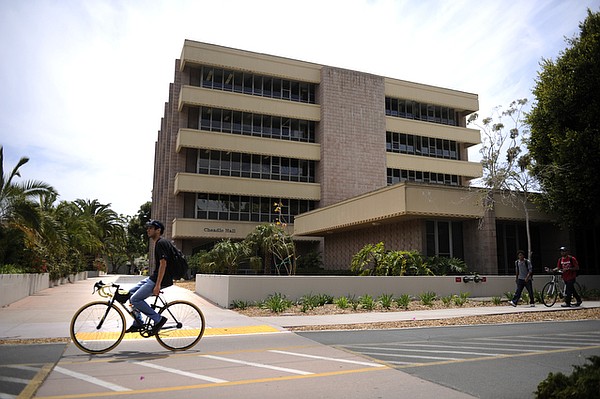Report Blasts UC Out-of-State Admissions
Says College System's Policy Shortchanges California Residents

On March 29, the California State Auditor released a report blistering the University of California’s practice of admitting large numbers of out-of-state students, even those who are less qualified than their Californian counterparts. System-wide, the report found, so-called nonresident enrollment has increased by 82 percent from 2010 to 2014 while in-state enrollment has only increased by one percent. At UCSB, nonresident enrollment has jumped by 72 percent at the same time in-state enrollment fell by 2 percent. About 13 percent of the roughly 23,000 undergrads at UCSB hail from out of California.
The audit recommends UC restrict nonresident enrollment and adopt stricter admissions criteria for nonresident applicants, among other things. UC officials have long contended that nonresident students — who pay $23,000 extra — helped make up for budget cuts the system endured during the recession. They are adamant such enrollees are not displacing California students. “We fill every single California spot with a California resident,” said UCSB admissions director Lisa Przekop. “We are funded by the state. If we have additional space, we can fill it with nonresidents.”
Still, state legislators said UC’s reliance on out-of-state dollars disadvantages Californians, particularly minorities, and called for the audit. The report found UCSB brought in $49.5 million in nonresident revenue, a 214 percent increase from five years ago. But exactly how that additional money is spent remains unclear. Even though UC officials argue those funds are essential to improving education quality and enrolling more Californians, the audit found “the university does not give campuses spending guidance or track how they use these funds.”
Because UCSB admits a lower number of out-of-state undergrads, it receives less state funding per student. UCSB got a bump a few years ago when the UC system embarked on what is dubbed “rebenching,” divvying up the additional revenues. But the playing field is not level.
“It’s the fig leaf,” said Bob Samuels, who teaches in UCSB’s writing program and is president of the University Council American Federation of Teachers. “UCSB has gotten a little more money from rebenching but nowhere as much as the other campuses like [UCLA, Berkeley, and San Diego] are getting from nonresident tuition.”
California residents have a harder time getting into those campuses, and sometimes end up at Riverside or UCSB, where they are funded at a lower level, Samuels added. “The report shows that because so many of the nonresident students are white, it’s actually decreased the diversity of the system,” he said.
What’s more, the audit found, nonresident students have increasingly enrolled in the five most popular majors at the same time resident enrollment in these majors has generally declined. (Last year, biology, psychology, economics, physics, and undeclared received the most freshman applications at UCSB .)
Critics charge out-of-state applicants bombard highly lucrative majors, hurting in-state residents’ chances of getting in. Contrary to popular belief, UCSB does not admit by major, Przekop said; it is not more difficult to get in as “undeclared.” Engineering, however, is “more competitive for all students.” Parents might be willing to pay more for their child to obtain an engineering degree than, for instance, one in liberal arts.
Nonresident students admitted to UCSB average a 3.98 GPA, slightly lower than California students, who averaged a 4.05 GPA, according to the report. Przekop chalked up these “quantitative data differences” to the different ways GPAs are calculated around the country and around the world. In addition, evaluators look beyond test scores and grades, and comprehensively review applicants “in light of the opportunities available to them,” she added.
Przekop noted UCSB has become better known nationwide in past years — “we didn’t have six Nobel laureates then”— and the fact that students can apply to multiple UC campuses with one application. Their in-state recruitment efforts, she stressed, far exceed out-of-state ones.
As many things are, this week’s frenzy is arguably largely about politics. “The audit kind of glazes over the cause: the Legislature repeatedly cut the higher-education budget,” said Assemblymember Das Williams. “They are operating at less money than in 2007 but at 2016 prices.” California State University, by contrast, had to cut state enrollment in the face of budget woes.
Asked if minority students have been disproportionally affected by this trend, Williams said no. “That’s an incomplete analysis,” he said. Without additional nonresident revenue, “things would have been even worse,” he said.



